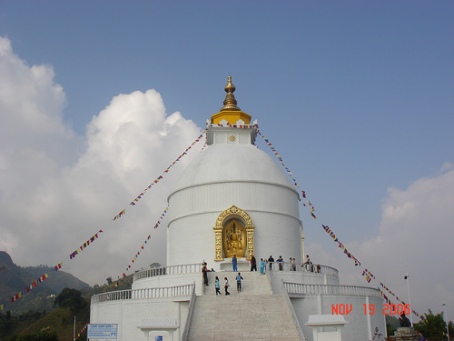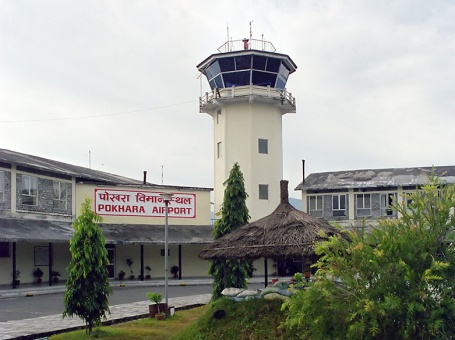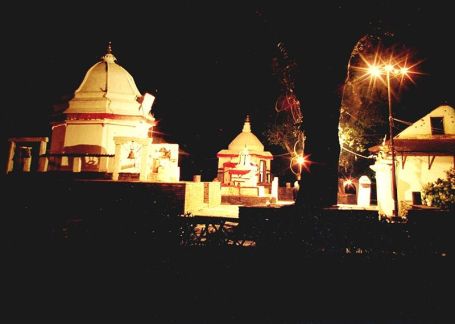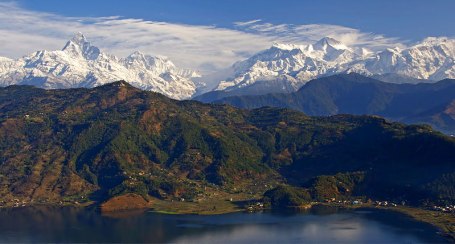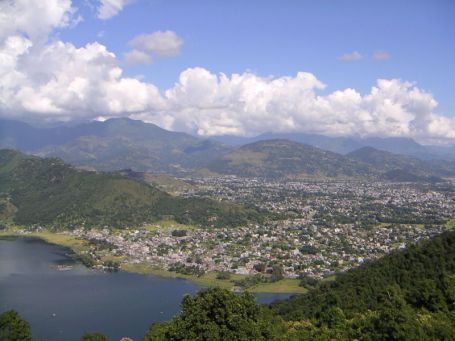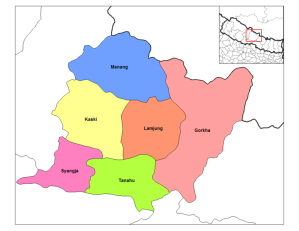Posts filed under ‘Gandaki Zone’
Gandaki Zone,Kaski District(Gufa or Gupha in Nepali)
Tourists Places in Pokhara
Mahendra Cave (Gufa or Gupha in Nepali)
Mahendra Cave resides in Batulechaur. Its a 10 minute drive from chipledhunga the central market place of the Pokhara city. Mahendra cave has been named as per the Late King Mahendra Bir Bikram Shah Dev. This is also one of the most demanding tourist attraction center here in pokhara. It resides in the northern settlements of the valley.
This cave is a natural tunnel which is provided with artificial lighting systems. Bulbs are used by the cave incharge so that the visitors can visit it without any difficulty. But do take a torch light with you just in case the electricity goes off.
Mahendra cave is rich for its rock types and different stones that glitters when a beam of light is striked in it. This natural formation is to see not to strike with sharp digging objects.
Devi’s Falls (Patale Chhango In Nepali) Pokhara is the only city in Nepal which is famous for water falls. As we drive by the river sides below the hills we can see several beautiful and dashing water falls flowing downhill and finally flowing to the rivers. The highway to Baglung consist of several water falls. The city itself has a Witness a unique waterfall that lies 2 Km from central Pokhara City. The water fall directly goes into a deep and narrow canal with no ends. It is believed that this deadly waterfall took the life of a tourist named David, who fell down into the canel and was never found, and hence the name David waterfall, named in his memory by the people of Pokhara. This place has many nick names like Davy’s Fall, David’s Fall or Davis’s Fall, all mean the same thing `The Davis Water Fall’
World Peace Stupa. Recently built atop a hill overlooking Phewa Tal, the Stupa offers a great place to see the sun set over Pokhara. It can be accessed by hiring a boat and rowing across the lake and climbing a sometimes leech-infested track, or by foot from the road that passes Devi Falls.
Phewa Lake and Lakeside view from Sarangkot
Phewa Lake and Lakeside view from Sarangkot
Sarangkot. The perfect pre-trek warm-up. Head up Sarankot in the late afternoon (be prepared, it’s steep and hard work) find yourselves a warm guest house before sunset, go up the top for sunset and again for sunrise… you won’t be disappointed. Great views, spectacular images and a great way to get a taste of what it’s like to be trekking. Beware demented water buffaloes on the way out of town!
Other places to visit in Pokhara are Barahi temple, situated in the middle of Phewa lake, Pokhara Museum, Annapurna Museum, Bindhyabasini temple, and World Peace Pagoda.
By Mukti Aryal
Gandaki Zone,Kaski District,(Pokhara Airport)
Pokhara Airport
Pokhara Airport is situated in the middle of town serving flights to Kathmandu, Jomsom, Manang, Bhairahawa and Bharatpur. Helicopters to Manang and Jomsom are also available for charter.
An interesting institution of Pokhara is the British Gurkha Camp in the north of the city. It has been established as a recruitment camp for Nepalis as Gurkha soldiers. About 370 are selected annually in December out of a pool of over 20,000 applicants. About 140 eventually join the Gurkha Contingent in Singapore while the rest join the British Army.
Gandaki Zone,Kaski District(Bindhyabasini Temple )
Tourism and Economy
After the annexation of Tibet by China the trading route to India became defunct. Today only few caravans from Mustang still arrive in Bagar.
Pokhara has become a major tourist hub of Nepal, more than making up for the loss of its trading importance. The city offers a combination of nature and culture with a distinct tourist district in the southern subdivisions of Baidam, Lakeside and Damside. It is mostly known as starting and ending point for Annapurna treks.Bindhyabasini Temple in the evening.
Pokhara is quite a modern city with only few touristic attractions in the town itself. Most interesting is the old centre in the north of the city (purano bazar) where still many old shops and warehouses in the Newari style can be found. Mule caravans still arrive there from Mustang.
Temples worth visiting in the older part of town are Bindhyabasini temple and Bhimsen temple. Another temple, Barahi temple, is located on an island in the Phewa Lake. It is accessible only through boats available at the shores of the lake.
In the top of the hill of sarankot there is a beautiful stupa/monasits of buddhists it is also a place for tourism.
The modern commercial city centre at Chiple Dhunga and Mahendrapul (now called Bhimsen Chowk, named after a Shahid(Martyr) in Jana-aandolan II, April, 2006) is halfway between the lake and Purano Bazar, the old centre. Apart from this there are several subcentres in other parts of town: in the north in Bagar, in the south between Prithvi Chok and Srijana Chok (mainly hardware stores), and in the east, on the other side of the Seti, in Ram Bazar.
On a hill overlooking Phewa Tal from the south is the World Peace Stupa (at 1,113 m) QTVR built in 1996 with a view of the lake, across the city and of the snow peaked mountain range consisting of namely, Fishtail, Annapurna and Dhaulagiri Himals (mountains).
The best viewpoint of Pokhara is Sarangkot (1600 m )and Thulakot (in Lekhnath a part of famous Royal Trek from where four lakes Phewa, Begnas, Khaste and Dipang and whole annapurna range is seen) to the west of the city. Paths and a road lead to the top from where one can enjoy spectacular views of the Annapurna range, Manaslu, Dhaulagiri and the city itself.
The shortage of touristic sites in Pokhara is made up by its scenic views in and around town. Most of them are not mentioned in any guide or map. The Seti Gandaki (White Gandaki) and its tributaries have created spectacular gorges in and around the whole city. The Seti gorge runs through the whole city from north to south. At places it is only a few metres wide, but 100 m deep with a water depth of 20 m.
In the middle of the city, the gorge widens to a canyon looking like a crater. In the north and south, just outside town, there are awesome canyons, in some places 100 m deep. These canyons extend through the whole Pokhara Valley. Impressive views are possible from the Prithvi Narayan Campus and from the other side at the foot of Kahu Danda (conjunction of several rivers and canyons). Behind the INF-Compound one can see the Seti River disappear into a slit in an almost 100 m wall, especially impressive in monsoon.
Another place worth visiting is the Patale Chhango (Hell’s Falls), more commonly called “Devi’s or David’s Falls” for the tourists with some melodramatic story behind it. The water of these falls comes from the Fewa Lake flowing to the Seti. The falls plunge into a hole and disappear. In monsoon this sight is most spectacular. Nearby, across the street is a little cave (Gupteshwor Cave). A more exciting cave is at the opposite end of the city in Batulechaur (Mahendra Cave). Betulechaur is known for the musicians caste of the Jains.
By Mukti Aryal
Gandaki Zone,Kaski District,(Pokhara Structure)
Structure
The Annapurna range from the World Peace Pagoda above Phewa lake
Pokhara spans 8 km from north to south and 6 km from east to west but, unlike Kathmandu, it is quite loosely built up and still has much green space. The Seti Gandaki flowing through the city from north to south divides the city roughly in two halves with the down-town area of Chipledunga in the middle, the old town centre of Bagar in the north and the tourist district of Lakeside (Baidam) in the south all lying on the western side of the river. The gorge through which the river flows is crossed at five points, the major ones are (from north to south): K.I. Singh Pul, Mahendra Pul and Prithvi Highway Pul. The eastern side of town is mainly residential.
About half of all tourists visiting Pokhara are there for the start or end of a trek to the Annapurna Base Camp and Mustang. For Nepalese, Pokhara has become the most favorite place to live in the country.
The Annapurna range from the World Peace Pagoda above Phewa lake
Phewa Lake was slightly enlarged by damming. It is in danger of silting up because of the inflow during the monsoon. The outflowing water is partially used for hydro power. The dam collapsed in the late 1970s and it was rebuilt by the Chinese. The power plant is located about 100 m below at the bottom of the Phusre Khola gorge. Water is also diverted for irrigation into the southern Pokhara valley.
The eastern Pokhara Valley receives irrigation water through a canal running from a reservoir by the Seti in the north of the city. Phewa Lake is also used for commercial fishing. The tourist area is along the north shore of the lake (Lake Side and Dam Side). It is mainly made up of little shops, little hotels, restaurants and bars. The larger hotels can be found on the southern and south-eastern fringes of the city, from where the view of the mountains, mainly Mt. Fishtail is seen best. To the east of the valley are few smaller and few bigger lakes, the largest being Begnas Tal and Rupakot Tal. Begnas Tal is also known for its fishery projects. There are no beaches in the valley, but one can rent boats Phewa and Begnas Tal. Pokhara Photo Gallery Divided Pokhara into 5 different parts.
Gandaki Zone,Kaski District (Pokhara Phewa Lake)
Pokhara
Phewa_Lake
पोखरा) is a city of close to 200,000 inhabitants in central Nepal located at 28.25 N, 83.99 E,, 198 km west of Kathmandu. It is the Headquarter of Kaski District, Gandaki Zone and the Western Development Region. It is also one of the most popular tourist destinations in Nepal. It is also called the Switzerland of Nepal.
* 1 Geography
* 2 History
* 3 Structure
* 4 Tourism and Economy
* 5 Pokhara Airport
* 6 Tourists Places in Pokhara
* 7 Lakes & Rivers
* 8 Universities and Schools in Pokhara
Geography
Pokhara is situated in the northwestern corner of the Pokhara Valley, which is a widening of the Seti Gandaki valley The Seti River and its tributaries have dug impressive canyons into the valley floor, which are only visible from higher viewpoints or from the air. To the east of Pokhara is the municipality of Lekhnath, another town in the valley.
In no other place do mountains rise so quickly. In this area, within 30 km, the elevation rises from 1000 m to over 7500 m. The Dhaulagiri, Annapurna and Manaslu ranges, each with peaks over 8000 m, can be seen from Pokhara and there is a lake named Phewa Lake, three caves (Mahendra, Bat and Gupteswor) and an impressive falls(Patale Chhango or David’s Fall) where the water from the Phewa Lake thunders into a hole and disappears. Due to this sharp rise in altitude the area of Pokhara has one of the highest precipitation rates of the country (over 4000 mm/year). Even within the city there is a noticeable difference in the amount of rain between the south of the city by the lake and the north at the foot of the mountains.
The climate is sub-tropical but due to the elevation the temperatures are moderate: the summer temperatures average between 25 – 35°C, in winter around 5 – 15°C.
In the south the city borders on Phewa Tal (a lake of 4.4 km² at an elevation of about 800 m above sea level), in the north at an elevation of around 1000 m the outskirts of the city touch the base of the Annapurna mountain range. From the southern fringes of the city 3 eight-thousanders (Dhaulagiri, Annapurna, Manaslu) and, in the middle of the Annapurna range, the Machapuchare (Nepali: Machhapucchare: ‘Fishtail’) with close to 7000 m can be seen. This mountain dominates the northern horizon of the city and its name derives from its twin peaks, not visible from the south.
[edit] History
Pokhara lies on an important old trading route between Tibet and India. In the 17th. century it was part of the influential Kingdom of Kaski which again was one of the Chaubise Rajaya (24 Kingdoms of Nepal) ruled by a branch of the Shah Dynasty. Many of the mountains around Pokhara still have medieval ruins from this time. In 1752 the King of Kaski invited Newars from Bhaktapur to Pokhara to promote trade. Their heritage can still be seen in the architecture along the streets in Bagar (Old Pokhara). Hindus, again, brought their culture and customs from Kathmandu and settled in the whole Pokhara valley. In 1786 Prithvi Narayan Shah added Pokhara into his kingdom. It had by then become an important trading place on the routes from Kathmandu to Jumla and from India to Tibet.
From 1959 to 1962 some 300,000 refugees came to Nepal from neighbouring Tibet, which had been annexed by China. Four refugee camps were established in the Pokhara valley: Tashipalkhel, Tashiling, Paljorling and Jambling. These camps have evolved into settlements. Because of their different architecture, prayer flags, gompas and chorten, these can easily be distinguished from the other settlements.
Until the end of the 1960s the town could only be reached by foot and it was considered even more a mystical place than Kathmandu. The first road was finished in 1968 after which tourism set in and the city grew rapidly. The area along the Phewa Lake developed into one of the major tourism hubs of Nepal.
पोखरा
Location in Nepal
Coordinates: [show location on an interactive map] 28°24′N 83°99′E / 28.4, 84.65
Country Nepal
Development Region Western
Zone Gandaki Zone
District Kaski District
Government
Mayor Area
Total 11.6 sq mi (30 km²)
Water 1.7 sq mi (4.4 km²)
Population (2006)
– Total 200,000
– Ethnicities Gurung,Newar
– Religions Buddhist,Hindu,Christian
Time zone GMT +5:45 (UTC)
Website: http://www.visitingnepal.com/pokhara-travel-and-tour-41.html
Gandaki Zone,Kaski District
Kaski District
Kaski District, a part of Gandaki Zone, is one of the seventy-five districts of Nepal, a landlocked country of South Asia.
The district, with Pokhara as its district headquarters, covers an area of 2,017km² and has a population (2001) of 380,527.
For the Polish village, see Kaski, Łódź Voivodeship.
Kaski District
Map of with Kaski District highlighted
Area 2,017km² km²
Population (2001)
• Density 380,527 • /km²
Time zone NPT (UTC+5:45)
Gandaki Zone,Gorkha District (Gorkha)
Gorkha
The name of today’s Nepalese City of Gorkha
The name of today’s District of Gorkha
The name of those rifle regiments of the modern Indian Army, successors of the Gurkhas of Britain’s imperial Indian Army.
The name of the medieval state of Gorkha
Nepalese official name as a state before 1930
Gorkha Beer, a brand of beer brewed in Nepal
See also Gurkha – the people from Nepal and parts of northern India, who take their name from the eighth century Hindu warrior-saint Guru Gorakhnath, and the name of the regiments recruited from these districts, that were a part of Britain’s Indian Army and which are now a part of today’s British Army.
Gandaki Zone,Gorkha District
Gorkha District
Gorkha District, a part of Gandaki Zone, is one of the seventy-five districts of Nepal, a landlocked country of South Asia. The district, with Gorkha as its district headquarters, covers an area of 3,610km² and has a population (2001) of 288,134. It is the location of the Manakamana Temple
Towns and villages
Aanppipal, Aaru Arbang, Aaru Chanuate, Aarupokhari, Asrang, Baguwa, Bakrang, Bhirkot, Bhumlichok, Bihi, Borlang, Bunkot, Chhaikampar, Chhoprak, Chumchet, Chyangli, Darbhung, Deurali, Dhawa, Dhuwakot, Finam, Fujel, Gaikhur, Gakhu, Ghairung, Ghyachok, Ghyalchok, Gorakhkali, Gumda, Hansapur, Harbhi, Jaubari, Kashigaun, Kerabari, Kerauja, Kharibot, Khoplang, Laprak, Lapu, Lho, Makaising, Manakamana, Manbu, Masel, Muchhok, Namjung, Nareshwor, Palumtar, Panchkhuwadeurali, Pandrung, Prithbinarayan, Prok, Ranishwara, Samagaun, Saurpani, Shreenathkot, Simjung, Sirdibas, Swara, Taklung, Takukot, Takumajhalakuribot, Tandrang, Tanglichok, Taple, Tara Nagar, Thalajung, Thumi, Uiya, Warpak
Area of Gandaki Zone with Gorkha District highlighted
Area 3,610 km²
Population (2001)
• Density 288,134
• /km²
Time zone NPT (UTC+5:45)
Gandaki Zone Map
Gandaki Zone
From Mukti Kumar search
The Gandaki zone lies in the western administrative region of Nepal. It is named as Sapta Ganadaki after the seven tributaries (Kali Gandak, Trishuli, Budhi Gandak, Marsyangdi, Madi, Seti Gandak, and Daraudi) that make up the Gandaki River. Pokhara serves as its regional and zonal capital. It is also the birthplace of Bhanubhakta Acharya, first poet of Nepal.
The Gandaki zone is home to multiple cultures which are unique in themselves. Some, like the Magar, Gurung, have made themselves famous as Gurkha fighters. Also it is home of Acharyas, descendants of Bhanubhakta Acharya.
Gandaki is divided into 6 districts, listed below with the headquarters in parentheses:
* Gorkha District (Gorkha)
* Kaski District (Pokhara)
* Lamjung District (Besisahar)
* Manang District (Chame)
* Syangja District (Syangja)
* Tanahu District (Damauli)
Annapurna Conservation Area
The Annapurna Conservation Area Project (ACAP)[1], the first and largest conservation area in Nepal, covers 7,629 sq. km (5.8% of the total land area of Nepal). Launched in 1986 as an innovative concept in the protected area management system of the country, the conservation area embraces multiple land use principles of resource management that combines environmental protection with sustainable community development. Traditional subsistence activities are woven into a framework of sound resource management, supplemented by conservation, development and alternative energy programmes to minimize the negative impacts of tourism and enhance the living standards of the local people.
Some of the activities of ACAP are a) Conservation of Resources, b) Community Development, c) Tourism Management and d) Conservation, Education and Extension
ACAP is spread out in 5 districts, of the Western Development Region of Nepal and covers 55 Village Development Committees (VDCs). ACAP is divided into seven unit conservation offices located in the field – Jomsom, Manang, Lho Manthang in the Northern Program section and Bhujung, Lwang, Sikles and Ghandruk in the Southern Program section. While the focus of Jomsom, Manang and Ghandruk, which are also popular areas for trekking, is on integrated tourism management and agro-pastoralism, the programme priorities for Bhujung, Sikles and Lwang are poverty alleviation and integrated agriculture and livestock development, agro-forestry, and community development respectively.
Each Village Development Committee (VDC) is assigned to carry out the responsibilities to manage, utilize and protect all the natural resources within the respective VDCs.
The biological diversity of the Annapurna Region is equally rivaled by its rich cultural diversity. Since the first trekker came to the Annapurna Sanctuary in 1957, the natural and cultural features of ACAP have made it the most popular tourist destination in Nepal, drawing more than 60 per cent of the country’s total trekkers. ACAP follows the three grass root philosophy of maximum peoples’ participation, sustainability, and its role as a catalyst (facilitator) whereby the local people are involved in all aspects of the conservation and development processes, both as principal actors and prime beneficiaries.
The Annapurna Conservation Area supports high diversity of flora and fauna species. A total of 1,226 species of plants (including 38 Orchid species and 9 Rhododendron species), 101 species of reptiles and 22 species of amphibians have been recorded in the ACA. The area harbors rare and endangered wildlife species such as the Snow Leopard, Musk Deer, Tibetan Argali, Impeyan Pheasant and Tragopan Pheasant. The ACA provides a large protected area with the entire habitat gradient from sub tropical Sal forests to perennial snow in which to maintain the Biodiversity and integrity of the central Himalayas.
The Marsyangdi river basin is in the heart of the ACAP.
By Mukti Aryal
